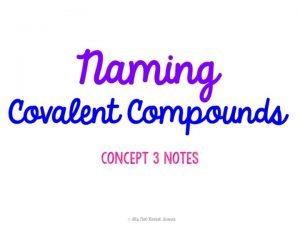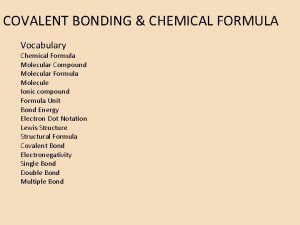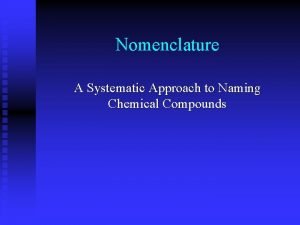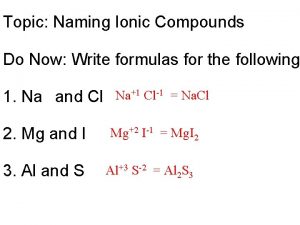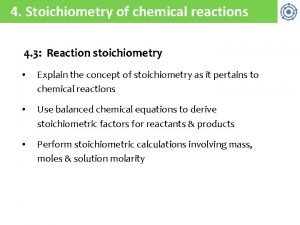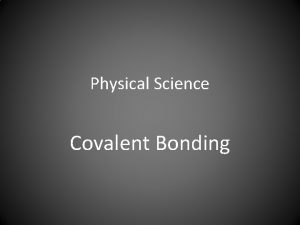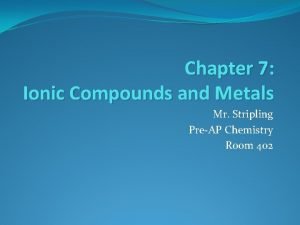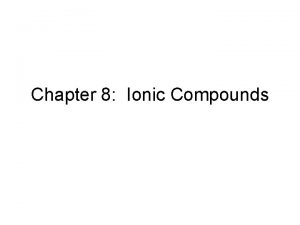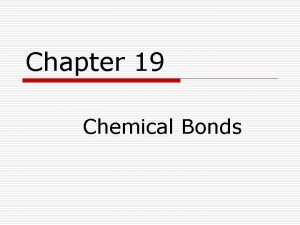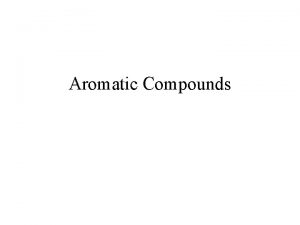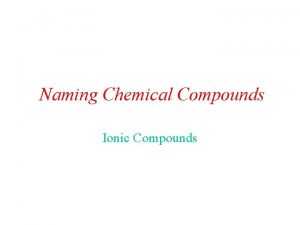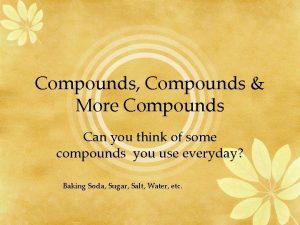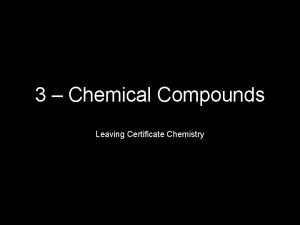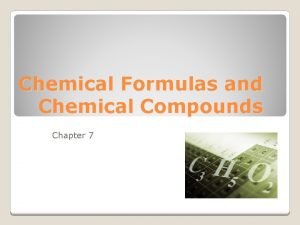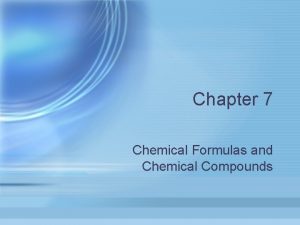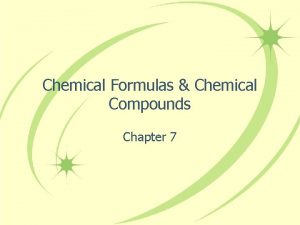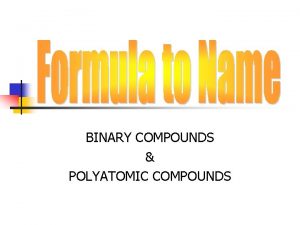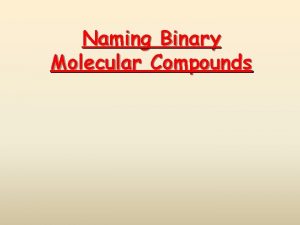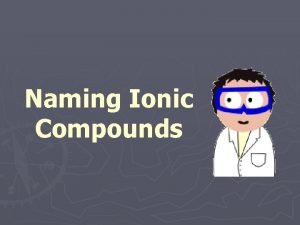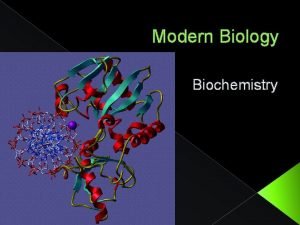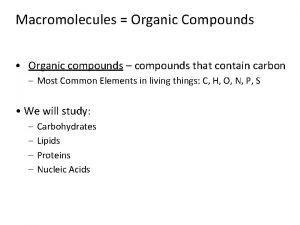Chapter 6 More on Chemical Compounds Chapter Map





































- Slides: 37

Chapter 6 More on Chemical Compounds

Chapter Map

Monatomic Ion Names • Monatomic Cations – (name of metal) • Groups 1, 2, and 3 metals • Al 3+, Zn 2+, Cd 2+, Ag+ – (name of metal)(Roman numeral) • All metallic cations not mentioned above • Monatomic Anions – (root of nonmetal name)ide

Roots of Nonmetals H hydr. C carb. N nitr. P phosph. O ox. S sulf. Se selen- F fluor. Cl chlor. Br brom. I iod-

Monatomic Anions H− Hydride Nitride N 3− Phosphide P 3− Oxide O 2− Sulfide S 2− selenide Se 2− fluoride F− chloride Cl− bromide Br− iodide I−

Polyatomic Ions Ion Name NH 4+ ammonium NO 3− nitrate OH− hydroxide SO 42− sulfate CO 32− carbonate C 2 H 3 O 2− acetate PO 43− phosphate

Polyatomic Ions with Hydrogen • • • HCO 3− HSO 4− HS− HPO 42− H 2 PO 4− hydrogen carbonate hydrogen sulfide hydrogen phosphate dihydrogen phosphate

Recognizing Ionic Compounds • Metal-nonmetal…binary ionic compound • Metal-polyatomic ion • Ammonium-nonmetal or ammonium polyatomic ion

Converting Ionic Formulas to Names • Name – (name of cation) (name of anion)

Cation Names Metals with one name of metal possible charge (Al, Zn, Cd, and Groups 1, 2, 3) Metals with more than name(Roman numeral) one possible charge (the rest) polyatomic cations (e. g. name of polyatomic ion ammonium)

Anion Names monatomic anion (root of nonmetal name)ide polyatomic anion name of polyatomic ion

Converting Ionic Names to Formulas • Determine the formula, including charge, for the cation and anion. • Determine the ratio of the ions that yields zero overall charge.

Monatomic Ions

Binary Covalent

Common Names –H 2 O, water –NH 3, ammonia –CH 4, methane –C 2 H 6, ethane –C 3 H 8, propane

Naming Binary Covalent Compounds • If the subscript for the first element is greater than one, indicate the subscript with a prefix. – We do not write mono- on the first name. – Leave the "a" off the end of the prefixes that end in "a" and the “o” off of mono- if they are placed in front of an element that begins with a vowel (oxygen or iodine). • Follow the prefix with the name of the first element in the formula.

Naming Binary Covalent Compounds • Write a prefix to indicate the subscript for the second element. • Write the root of the name of the second symbol in the formula. • Add -ide to the end of the name.

Prefixes mon(o) di tri tetr(a) pent(a) hex(a) hept(a) oct(a) non(a) dec(a)

Roots of Nonmetals H hydr. C carb. N nitr. P phosph. O ox. S sulf. Se selen- F fluor. Cl chlor. Br brom. I iod-

Forms of Binary Covalent Names • prefix(name of nonmetal) prefix(root of name of nonmetal)ide • (for example, dinitrogen pentoxide) • or (name of nonmetal) prefix(root of name of nonmetal)ide • (for example, carbon dioxide) • or (name of nonmetal) (root of nonmetal)ide • (for example, hydrogen fluoride)

Writing Binary Covalent Formulas • Write the symbols for the elements in the order mentioned in the name. • Write subscripts indicated by the prefixes. If the first part of the name has no prefix, assume it is mono-.

Arrhenius Acid Definition • An acid is a substance that generates hydronium ions, H 3 O+ (often described as H+), when added to water. • An acidic solution is a solution with a significant concentration of H 3 O+ ions.

Characteristics of Acids · Acids have a sour taste. · Acids turn litmus from blue to red. · Acids react with bases.

Strong Acid and Water When HCl dissolves in water, hydronium ions, H 3 O+, and chloride ions, Cl−, ions form.

Solution of a Strong Acid

Types of Acids • Binary acids have the general formula of HX(aq) – HF(aq), HCl(aq), HBr(aq), and HI(aq) • Oxyacids have the general formula Ha. Xb. Oc. – HNO 3 and H 2 SO 4 • Organic (carbon-based) acids – HC 2 H 3 O 2

Acetic Acid

Monoprotic and Polyprotic Acids • If each molecule of an acid can donate one hydrogen ion, the acid is called a monoprotic acid. • If each molecule can donate two or more hydrogen ions, the acid is a polyprotic acid. • A diprotic acid, such as sulfuric acid, H 2 SO 4, has two acidic hydrogen atoms. • Some acids, such as phosphoric acid, H 3 PO 4, are triprotic acids.

Strong and Weak Acids • Strong Acid = due to a completion reaction with water, generates close to one H 3 O+ for each acid molecule added to water. • Weak Acid = due to a reversible reaction with water, generates significantly less than one H 3 O+ for each molecule of acid added to water.

Weak Acid and Water Acetic acid reacts with water in a reversible reaction, which forms hydronium and acetate ions.

Solution of Weak Acid

Strong and Weak Acids

Sulfuric Acid H 2 SO 4(aq) + H 2 O(l) H 3 O+(aq) + HSO 4 -(aq) + H 2 O(l) H 3 O+(aq) + SO 42 -(aq)

Acid Summary Strong hydrochloric acid, HCl(aq) Weak hydrofluoric acid Oxyacid nitric acid, HNO 3 sulfuric acid, H 2 SO 4 other acids with Ha. Xb. Oc Organic acid none acetic acid, HC 2 H 3 O 2 Binary acid

Names and Formulas of Binary Acids • Names have the general form of hydro(root)ic acid, such as hydrochloric acid. • The formulas are usually followed by (aq), such as HCl(aq).

Names and Formulas for Oxyacids • If enough H+ ions are added to a (root)ate polyatomic ion to completely neutralize its charge, the (root)ic acid is formed. – Nitrate, NO 3−, goes to nitric acid, HNO 3. – Sulfate, SO 42−, goes to sulfuric acid, H 2 SO 4. (Note the -ur- in the name. ) – Phosphate, PO 43−, goes to phosphoric acid, H 3 PO 4. (Note the -or- in the name. )

Chemical Nomenclature • General procedure for naming compounds (See Table 5. 5 in the text. ) – Step 1: Decide what type of compound the name or formula represents. – Step 2: Apply the rules for writing the name or formula for that type of compound.
 Lirik lagu more more more we praise you
Lirik lagu more more more we praise you More more more i want more more more more we praise you
More more more i want more more more more we praise you Empirical formula pogil
Empirical formula pogil Chapter 7 chemical formulas and chemical compounds
Chapter 7 chemical formulas and chemical compounds Ionic covalent metallic bonds
Ionic covalent metallic bonds Criss-cross method chemistry worksheet
Criss-cross method chemistry worksheet Rules for naming ionic compounds
Rules for naming ionic compounds Rules for naming ionic compounds
Rules for naming ionic compounds Unit chemical bonding forming ionic compounds ws 2
Unit chemical bonding forming ionic compounds ws 2 Covalent compound chemical formula
Covalent compound chemical formula Difference between molecular and covalent
Difference between molecular and covalent Systematic approach to naming chemical compounds
Systematic approach to naming chemical compounds Naming chemical compounds flowchart
Naming chemical compounds flowchart Chemical compounds
Chemical compounds Are kc and kp equal
Are kc and kp equal 5 apples in a basket riddle
5 apples in a basket riddle The more you study the more you learn
The more you study the more you learn Aspire not to have more but to be more
Aspire not to have more but to be more Inertia examples
Inertia examples Knowing more remembering more
Knowing more remembering more More love to thee o lord
More love to thee o lord More choices more chances
More choices more chances Human history becomes more and more a race
Human history becomes more and more a race Ionic compound properties
Ionic compound properties Chapter 7 chapter assessment ionic compounds and metals
Chapter 7 chapter assessment ionic compounds and metals Predicting products of chemical reactions
Predicting products of chemical reactions Section 2 classifying chemical reactions worksheet answers
Section 2 classifying chemical reactions worksheet answers Section 2 classifying chemical reactions worksheet answers
Section 2 classifying chemical reactions worksheet answers Chemical reactions section 1 chemical changes
Chemical reactions section 1 chemical changes Hydrogen bonding concept map
Hydrogen bonding concept map Stoichiometry map for chemical reactions
Stoichiometry map for chemical reactions Concept map of covalent bond
Concept map of covalent bond Chapter 7 ionic compounds and metals
Chapter 7 ionic compounds and metals Chapter 6 section 1 atoms elements and compounds
Chapter 6 section 1 atoms elements and compounds Chapter 7 ionic compounds and metals assessment answer key
Chapter 7 ionic compounds and metals assessment answer key Chapter 6 section 1 atoms elements and compounds
Chapter 6 section 1 atoms elements and compounds Chapter 8 ionic compounds
Chapter 8 ionic compounds Chapter 10 chemical reactions
Chapter 10 chemical reactions









